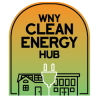Regional Assessment and Barriers Analysis

The purpose of the WNY Regional Clean Energy Hub’s Regional Assessment and Barriers Analysis (RABA) is to provide local communities with baseline information and data about socioeconomic conditions, workforce and labor market trends, the impact of climate change and environmental pollution, and barriers and opportunities associated with a just transition to a clean, renewable energy economy. Read the executive summary below or the full text (PDF).
Executive Summary
The study will inform the development of the Hub’s equitable engagement strategy, including how the Hub can best leverage sector-based stakeholder networks to deliver NYSERDA programs to Disadvantaged Communities (DACs). The WNY Hub has conceived of the RABA as a living project that will iterate and be updated over time as new data becomes available, new trends emerge, and new relationships are cultivated with stakeholders and program participants. The ongoing participation of these groups, and the local knowledge they possess, are absolutely essential for the Hub’s vision of the RABA to be realized. As a result, the WNY Hub will seek to organize a permanent formation of community advisors who can be called upon to ground truth, trouble shoot, and problem solve in support of the Hub’s mission.
The WNY Hub prioritized the following objectives for the RABA:
- Raise public awareness among key stakeholders and community residents of both the goals of the Climate Leadership and Community Protection Act (CLCPA or Climate Law) and how the WNY Regional Clean Energy Hub intends to operate as a tool to meet the goals of the Climate Law, in particular, within DACs;
- Identify existing or emergent networks of sector-based stakeholders that could be engaged to contribute meaningful information and insights about population-level barriers related to social determinants of health and access to clean energy and energy efficiency;
- Collect critical insights from stakeholders through in-depth interviews;
- Measure or test stakeholder insights against the direct lived experiences of marginalized (BIPOC; low-to-moderate income) community members through focus group conversations across the five counties of the region;
- Deliver a set of baseline analyses and recommendations for mitigating or overcoming barriers to access faced by low-to-moderate income households and DACs.
Key Findings
- DACs in WNY are highly racialized. BIPOC residents are disproportionately represented in DACs. While BIPOC residents constitute approximately 22% of the overall population in WNY, around 49% of residents of DACs in the region are BIPOC.
- DAC populations are concentrated in the City of Buffalo. Nearly 50% of all DAC households in the region are located in Buffalo.
- Income inequality is high across the region. The top 20% of income earners generate 42% of the region’s income, while the bottom 20% of earners account for slightly less than 3% of the region’s income.
- Social determinants of marginalization are disproportionately concentrated in DACs. The number of single-parent households, persons with limited English language proficiency, adults without high school equivalency or college degrees, households without vehicles, and persons with limited or no broadband internet connections are higher in DACs across the region compared to non-DACs.
- The housing stock in WNY is old. Housing in DACs, however, is considerably older and in relatively worse condition compared to housing outside of DACs.
- Housing cost burdens are high across the region, in particular for renters. Renters represent a majority of occupied households in DACs. More than 50% of renters residing in DACs pay more than 30% of their income on housing costs, a standardized measure of housing affordability.
- NYSERDA’s means-tested energy efficiency programs (Assisted Home Performance, EmPower, and EmPower+) have reached only a fraction of eligible households in WNY. From 2011-2022, approximately 12% of residents eligible for Assisted Home Performance incentives received support from NYSERDA. From 2018-2023, less than 4% of residents eligible for EmPower/+ received assistance. On average, approximately 2,000 total means-tested energy efficiency projects have been completed annually in recent years. Projects in rural counties have received relatively larger per unit investments and higher associated energy and utility bill cost savings.
- From 2008-2023, NYSERDA’s NY-SUN residential rooftop solar incentives reached less than 1% of eligible households in the region. Installations in the region have generally grown since 2008 with periods of fluctuating growth and decline since 2014.
Western New York's Poverty Rate
Health Effects of Air Quality
Lorem ipsum dolor sit amet, consectetur adipiscing elit. Ut elit tellus, luctus nec ullamcorper mattis, pulvinar dapibus leo.


